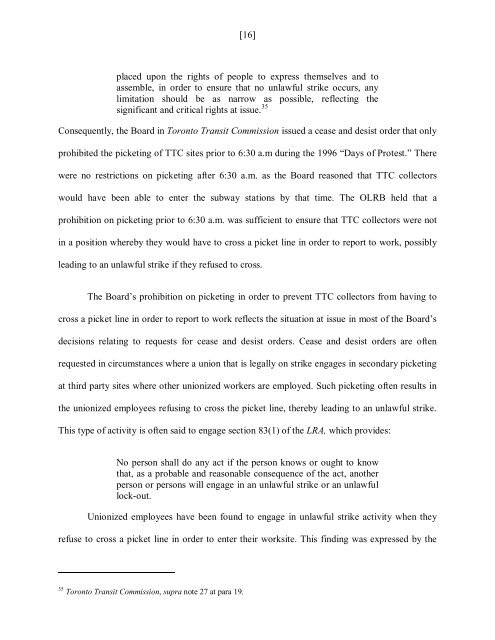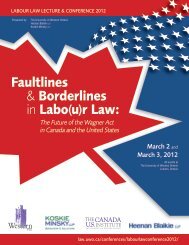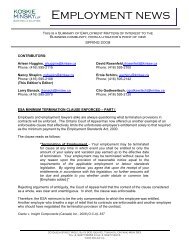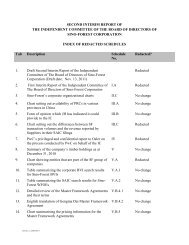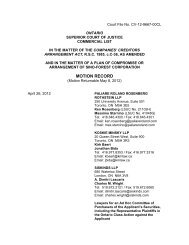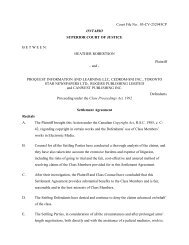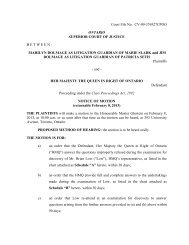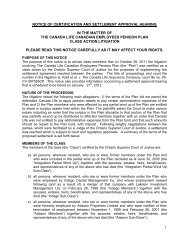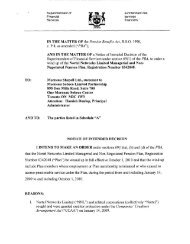Labour Injunctions & Cease and Desist Orders in Ontario
Labour Injunctions & Cease and Desist Orders in Ontario
Labour Injunctions & Cease and Desist Orders in Ontario
Create successful ePaper yourself
Turn your PDF publications into a flip-book with our unique Google optimized e-Paper software.
[16]<br />
placed upon the rights of people to express themselves <strong>and</strong> to<br />
assemble, <strong>in</strong> order to ensure that no unlawful strike occurs, any<br />
limitation should be as narrow as possible, reflect<strong>in</strong>g the<br />
significant <strong>and</strong> critical rights at issue. 35<br />
Consequently, the Board <strong>in</strong> Toronto Transit Commission issued a cease <strong>and</strong> desist order that only<br />
prohibited the picket<strong>in</strong>g of TTC sites prior to 6:30 a.m dur<strong>in</strong>g the 1996 “Days of Protest.”There<br />
were no restrictions on picket<strong>in</strong>g after 6:30 a.m. as the Board reasoned that TTC collectors<br />
would have been able to enter the subway stations by that time. The OLRB held that a<br />
prohibition on picket<strong>in</strong>g prior to 6:30 a.m. was sufficient to ensure that TTC collectors were not<br />
<strong>in</strong> a position whereby they would have to cross a picket l<strong>in</strong>e <strong>in</strong> order to report to work, possibly<br />
lead<strong>in</strong>g to an unlawful strike if they refused to cross.<br />
The Board’s prohibition on picket<strong>in</strong>g <strong>in</strong> order to prevent TTC collectors from hav<strong>in</strong>g to<br />
cross a picket l<strong>in</strong>e <strong>in</strong> order to report to work reflects the situation at issue <strong>in</strong> most of the Board’s<br />
decisions relat<strong>in</strong>g to requests for cease <strong>and</strong> desist orders. <strong>Cease</strong> <strong>and</strong> desist orders are often<br />
requested <strong>in</strong> circumstances where a union that is legally on strike engages <strong>in</strong> secondary picket<strong>in</strong>g<br />
at third party sites where other unionized workers are employed. Such picket<strong>in</strong>g often results <strong>in</strong><br />
the unionized employees refus<strong>in</strong>g to cross the picket l<strong>in</strong>e, thereby lead<strong>in</strong>g to an unlawful strike.<br />
This type of activity is often said to engage section 83(1) of the LRA, which provides:<br />
No person shall do any act if the person knows or ought to know<br />
that, as a probable <strong>and</strong> reasonable consequence of the act, another<br />
person or persons will engage <strong>in</strong> an unlawful strike or an unlawful<br />
lock-out.<br />
Unionized employees have been found to engage <strong>in</strong> unlawful strike activity when they<br />
refuse to cross a picket l<strong>in</strong>e <strong>in</strong> order to enter their worksite. This f<strong>in</strong>d<strong>in</strong>g was expressed by the<br />
35 Toronto Transit Commission, supra note 27 at para 19.


